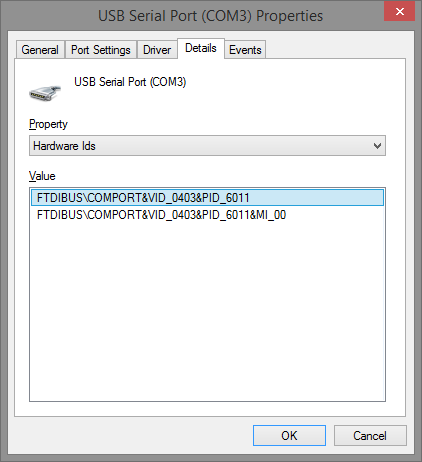Support for WinCE. FTDI drivers are available for Windows CE 4.2-5.2, 6.0/7.0 and 2013. Support for older versions of Windows Desktop. NOTE: Microsoft have ended support for certifying XP and VISTA through their WHCK test program. Select 'Dual RS232-HS (Interface 0)“ then select replacement driver 'WinUSB v6.1.xxxx' and finaly click on replace driver button. When you connect your adapter to different USB port of your computer, it is necesary to change driver settings via zadig tool again, otehwise openOCD will not find your adapter.
PlatformIO core: 4.3.4, Home 3.2.3
Target board D1 mini ESP32 (board = wemos_d1_mini32)
Debugger: Expressif ESP-PROG
Development computer: Window 10
Initially when I plugged the debugger into a usb port my pc would make a sound and it would show up in the Device Manager as a COM port. I was successfully able to debug a blink sketch. I had not connected the tx and rx wires so I was using a second usb plugged into my D1-mini-ESP32.
Then I did some more work on my project and then when I plugged the debugger in it didn’t show up in the Device Manager as a COM Port. I’m not sure if something happened to the esp-prog hardware or if I screwed up the device drivers on my PC.
Note: COM1 is on my motherboard
Here is the PlatformIO log
And, Zadig no longer shows the FDTI driver available for replacement. Is activating the FTDI drive just a onetime thing and after that the only choice is to update to the WinUSB? Is there a way to reinstall the FTDI? Interestingly in the device manager with only the ESP-Prog plugged in it shows two Dual RS232-HS devices but no COM port. Makes me think I’ve screwed something up with the device drivers.
Here is a screen shot of the Device manager with both the target board and esp-prog plugged in using separate USB cables.
I think I’ve tried all of the obvious things including: trying a different USB cable, rebooting my PC. At one point I used the Device Manager to delete both of the Dual RS232-HS devise and the FTDI COM device and rebooted my PC, no change. I’ve rerun Zadig many times but the FTDI Bus drive never shows up again. I’ve tried reinstalling the driver but that hasn’t helped.
I realize this is probably not related to PlatformIO but there don’t seem to be many that understand configuring the ESP-Prog and @manuelbl seems to understand how all of this is supposed to work.
Thanks for your support and the GREAT PlatformIO IDE.
All versions of ESP-WROVER-KIT boards have built-in JTAG functionality. Putting it to work requires setting jumpers or DIP switches to enable JTAG functionality, and configuring USB drivers. Please refer to step by step instructions below.
Configure Hardware¶
Enable on-board JTAG functionality by setting JP8 according to ESP-WROVER-KIT V4.1 Getting Started Guide, Section Setup Options.
Verify if ESP32 pins used for JTAG communication are not connected to some other h/w that may disturb JTAG operation:
ESP32 JTAG pins¶ ESP32 Pin
JTAG Signal
MTDO / GPIO15
TDO
MTDI / GPIO12
TDI
MTCK / GPIO13
TCK
MTMS / GPIO14
TMS
GND
GND
Configure USB Drivers¶
Install and configure USB drivers, so OpenOCD is able to communicate with JTAG interface on ESP-WROVER-KIT board as well as with UART interface used to upload application for flash. Follow steps below specific to your operating system.

Note

ESP-WROVER-KIT uses an FT2232 adapter. The following instructions can also be used for other FT2232 based JTAG adapters.
Windows¶
Using standard USB A / micro USB B cable connect ESP-WROVER-KIT to the computer. Switch the ESP-WROVER-KIT on.
Wait until USB ports of ESP-WROVER-KIT are recognized by Windows and drives are installed. If they do not install automatically, then download them from https://www.ftdichip.com/Drivers/D2XX.htm and install manually.
Download Zadig tool (Zadig_X.X.exe) from https://zadig.akeo.ie/ and run it.
In Zadig tool go to “Options” and check “List All Devices”.
Check the list of devices that should contain two ESP-WROVER-KIT specific USB entries: “Dual RS232-HS (Interface 0)” and “Dual RS232-HS (Interface 1)”. The driver name would be “FTDIBUS (vxxxx)” and USB ID: 0403 6010.
The first device (Dual RS232-HS (Interface 0)) is connected to the JTAG port of the ESP32. Original “FTDIBUS (vxxxx)” driver of this device should be replaced with “WinUSB (v6xxxxx)”. To do so, select “Dual RS232-HS (Interface 0) and reinstall attached driver to the “WinUSB (v6xxxxx)”, see picture above.
Note
Do not change the second device “Dual RS232-HS (Interface 1)”. It is routed to ESP32’s serial port (UART) used for upload of application to ESP32’s flash.
Now ESP-WROVER-KIT’s JTAG interface should be available to the OpenOCD. To carry on with debugging environment setup, proceed to section Run OpenOCD.
Linux¶
Using standard USB A / micro USB B cable connect ESP-WROVER-KIT board to the computer. Power on the board.
Open a terminal, enter
ls-l/dev/ttyUSB*command and check, if board’s USB ports are recognized by the OS. You are looking for similar result:Following section “Permissions delegation” in OpenOCD’s README, set up the access permissions to both USB ports.
Log off and login, then cycle the power to the board to make the changes effective. In terminal enter again
ls-l/dev/ttyUSB*command to verify, if group-owner has changed fromdialouttoplugdev:If you see similar result and you are a member of
plugdevgroup, then the set up is complete.The
/dev/ttyUSBninterface with lower number is used for JTAG communication. The other interface is routed to ESP32’s serial port (UART) used for upload of application to ESP32’s flash.
Now ESP-WROVER-KIT’s JTAG interface should be available to the OpenOCD. To carry on with debugging environment setup, proceed to section Run OpenOCD.
MacOS¶
On macOS, using FT2232 for JTAG and serial port at the same time needs some additional steps. When the OS loads FTDI serial port driver, it does so for both channels of FT2232 chip. However only one of these channels is used as a serial port, while the other is used as JTAG. If the OS has loaded FTDI serial port driver for the channel used for JTAG, OpenOCD will not be able to connect to the chip. There are two ways around this:
Manually unload the FTDI serial port driver before starting OpenOCD, start OpenOCD, then load the serial port driver.
Modify FTDI driver configuration so that it doesn’t load itself for channel B of FT2232 chip, which is the channel used for JTAG on ESP-WROVER-KIT.

Manually unloading the driver¶
Install FTDI driver from https://www.ftdichip.com/Drivers/VCP.htm
Connect USB cable to the ESP-WROVER-KIT.
Unload the serial port driver:
In some cases you may need to unload Apple’s FTDI driver as well:
macOS < 10.15:
macOS 10.15:
Warning
Attempting to use serial over the wrong channel with the FTDI driver will cause a kernel panic. The ESP-WROVER-KIT uses channel A for JTAG and channel B for serial.
Run OpenOCD:
In another terminal window, load FTDI serial port driver again:
Note
If you need to restart OpenOCD, there is no need to unload FTDI driver again — just stop OpenOCD and start it again. The driver only needs to be unloaded if ESP-WROVER-KIT was reconnected or power was toggled.
This procedure can be wrapped into a shell script, if desired.
Dual Rs232-hs Driver Update
Modifying FTDI driver¶
In a nutshell, this approach requires modification to FTDI driver configuration file, which prevents the driver from being loaded for channel B of FT2232H.
Note
Other boards may use channel A for JTAG, so use this option with caution.
Warning
This approach also needs signature verification of drivers to be disabled, so may not be acceptable for all users.
Open FTDI driver configuration file using a text editor (note
sudo):Find and delete the following lines:
Save and close the file
Disable driver signature verification:
Open Apple logo menu, choose “Restart…”
When you hear the chime after reboot, press CMD+R immediately
Once Recovery mode starts up, open Terminal
Run the command:
Restart again
Dual Rs232-hs Windows 10 Driver
After these steps, serial port and JTAG can be used at the same time.
Dual Rs232-hs Driver Windows 10
To carry on with debugging environment setup, proceed to section Run OpenOCD.